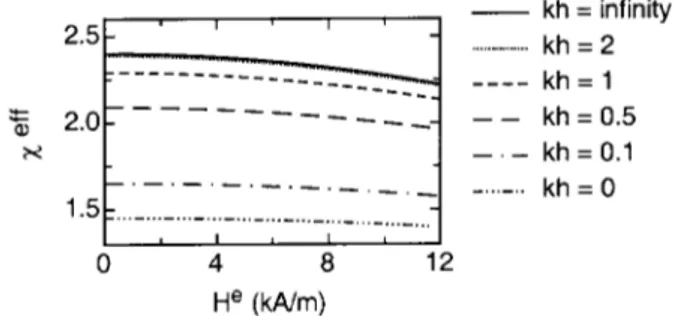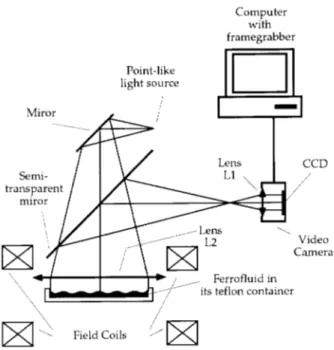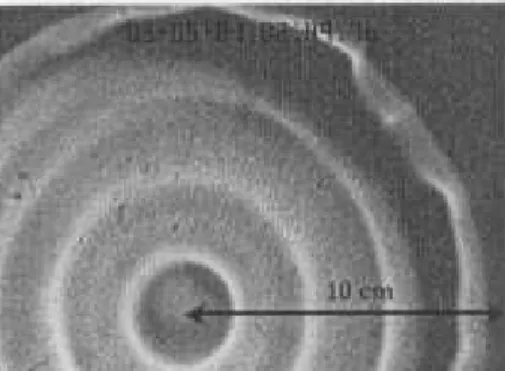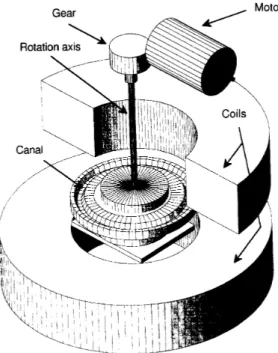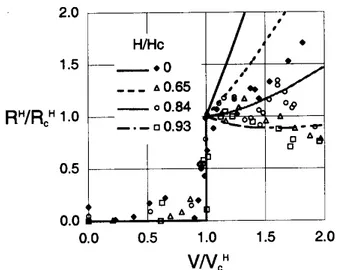Surfae Waves and Wave Resistane
in Magneti Fluids
J. Browaeys y z
, R.Perzynski
,J.-C. Bari
, and M. I. Shliomis x
Reeivedon15February,2001
We present here the experimentaldetermination of the dispersion relation of surfae waves of a
ferrouidsubmittedtoasteadyvertialmagnetield. Theresultsareomparedtoalineartheory
whereall themagnetiharateristisoftheuidhavebeentakenintoaount. Theknowledgeof
thedispersionequationisthenusedtoanalysetheapillary-waveresistane,thatisthedragfore
assoiatedtotheemissionofwavesbyamovingdisturbaneatafreeuidsurfae. Itundergoesa
transitionfromzerotoanitevalueasthespeedofthedisturbanereahesaertainritialvalue.
Theeetof visosity is explored, and amagnetiuidis shownto allow ontrolling theritial
speeds. Contrary to the theoretialmodel, however, themeasured wave resistane reveals a non
monotonispeeddependeneafterthethreshold.
I Introdution
Magneti uids, sometimes alled ferrouids, are
ol-loidal suspension of magneti partile whih have a
giant magneti suseptibility, usually in the order of
unity. When submittedto he inuene of anexternal
DCvertialmagnetield,oneisstrikenbythe
stru-turation of its surfae into peaks, usually distributed
on an quasi-hexagonal array. The linear analysis of
this phenomenon [1℄, alled after its disoverer the
\Rosensweiginstability"hasbeenthefoundationstone
offerrohydrodynamis[2℄,thethermo-hydrodynamis
of non-onduting magneti liquids. The uid peaks
arisebeauseapillary-gravitywaves,eitherinduedby
thermalutuationsorambientvibrations,are
ampli-edwhenasuÆientlystrongvertialmagnetieldis
present.
Thepreiseknowledgeofthedispersionequationis
ofparamountimportaneforanyproessthatis
sensi-tive tosurfaeinstabilities. Infat,everylassial
hy-drodynamial instability suh as the Rayleigh-Taylor,
or Benard-Marangoni instabilities [3℄, has a magneti
ounterpart with ferrouids. The additionalmagneti
eld,atingasanewontrolparameter,usuallyallows
toontrol thethresholdoftheinstability[4℄.
Therstpartofthispaperdealswiththe
measure-mentofthedispersionequationofapillary-gravity
sur-fae wavesofamagnetiuidunder theinueneof a
vertialandsteadymagnetield. Theresultsare
on-frontedtoalineartheorythattakesintoaountallthe
magneti harateristis ofthe ferrouidsample used.
The resultsare then used to analyse athreshold
phe-nomenon: theapillary-gravitywaveresistane.
When an objet is moved at the free surfae of a
uid,itexperienesadragforewhihphysially
orig-inatesfrom: (a)bulkdissipationinavisousboundary
layerfor lowReynolds numbers, and in the turbulent
wake for high Reynolds numbers; (b) the emission of
apillary-gravitysurfaewaves.Suhwavesremove
mo-mentum from theperturbatingobjetto innity. The
assoiated fore that the objet experienes is alled
wave resistane.
For the onvenient moderate speeds on whih we
fous in this paperit may overome the bulk
dissipa-tion type drag. Wave resistane hasbeen studied for
morethanaentury in theaseofpure gravitywaves
[5℄, mainly beausethis topi hasobviousnaval
appli-ations[6℄. Howevertheaseofapillary-gravitywaves
hasonlybeentheoretiallytreatedin areentworkof
Raphaeland de Gennes[7℄. The dispersiveproperties
ofsuhwavesaresuhasthereexistsaminimumphase
speedV
=(4g=) 1=4
atwhihwavesareableto
prop-agate(here isthesurfaetensionof thefreeair-uid
interfaeandthedensityoftheuid). Sinethewave
patternisstationaryintherefereneframeofthe
mov-ingobjet,nowaveanbeemittedforV <V
[8℄,and
therefore there is no wave resistanein that ase. As
modeledin[7℄,thewaveresistaneshouldexperienea
GroupeFerrouideassoieal'UniversiteDenisDiderot-Laboratoiredesmilieuxdesordonnesetheterogenes,UMRCNRS7603
UniversitePierreetMarieCurie,ase86,4plaeJussieu75252ParisCedex05,Frane.
y
LaboratoiredeBio-rheologieetd'HydrodynamiquePhysio-himique,ESACNRS7057UniversiteDenisDiderot,ase7056,2plae
Jussieu75251ParisCedex05,Frane.
z
E-mail:browaeysr.jussieu.fr
nite jump R
at V =V
andinreasesaboveV
. The
systemisthussupposedtoundergoadisontinuous
bi-furation.
The seond part of this work deals with the
mea-surementofthewaveresistane. Inordertohekthese
theoretialpreditionsitisneessarytovaryV
.
Vary-ingandisveryineetivewaytohangeV
(itwould
merely vary from 17 m/s to 23 m/sfor any kindof
uid). Wehereshowtheoretially andexperimentally
that theationofamagnetield onamagneti uid
providesameans totune theritial veloity from its
maximumvalueV H=0
=(4g=) 1=4
downto 0.
II Surfae waves
1.1 Dispersionequation
Cowley&Rosensweig[1℄werethersttostudythe
peakinstabilityatthefreesurfaeofamagnetiuid.
Although they didn't atually express the dispersion
equation for waves at the free surfae of a ferrouid
(theywereinterestedinthethresholdvalueofthe
mag-netieldatwhihthepeaksform),theydevelopedthe
linear theory whih allowsto diretlyderive the
mag-netiterminthedispersionequation. Theyonsidered
thattheferrouidwasinvisid,thatitsdepthwas
in-niteandthatitwasinnitelyextendedinthehorizontal
diretion.
Sine then, other authors rened this analysis
in-ludingmorerealistionditions: Zelazo&Melher[9℄
expressedthedispersionequationofsurfaewavesofa
ferrouidlayer restingbetweenthe poles ofamagnet.
More reently, Abou & al. [10℄ hanged this
bound-aryondition(thelayerisgenerallysurroundedbyfree
spae,for visualizationpurposes),andinludedthe
ef-fet of visosity. However, they omitted to take into
aount the demagnetization oeÆient and also
sup-posed that the permeability of the material was
on-stant,afatthatisnotsupportedexperimentally,sine
amagnetizationsaturationexistsinthematerial. This
shortoming hasbeenremovedin anartile ofthe
o-authors[11℄.
Inordertosimplify,onlytheirmainresultsare
pre-sentedhere. Intheaseofonstantpermeabilityforan
invisid uid of innite depth, the dispersion relation
writes:
! 2
=gk+ k
3
0 H
e2
k 2
2
(1+)(2+)
; (1)
where!isthepulsation,kthewavevetor,gthe
grav-itational aeleration, the surfaetensionofthe
fer-rouidlayer,itsdensity,
0
thevauumpermeability,
H e
theexternalvertialmagnetieldandthe
mag-Figure 1. Dispersion relation of surfae waves in a
fer-rouid. Here!
=2(g
3
=) 1=4
is introdued tonormalize
the urves. It orresponds to the pulsation when k = k
withoutmagnetield.
Therst twotermsof theright sideof eq. (1) are
lassial and respetively aount for the gravity and
apillarity eet. The last term inludes the eet of
themagneti eld. It is a destabilizingterm : at the
ritialeld H
, the dispersionurve(Fig. 1) adjoins
the zero frequeny axis at a non zero wavevetor k
.
Analytialderivationyields:
H
=
s
2(1+)(2+)
2
p
g
0
(2)
k
=
r
g
(3)
It is noteworthy that the wavevetor at the
thresh-oldoftheRosensweiginstabilityisindeedtheapillary
wavevetor.
Inthemorerealisti asewherethe uidlayerhas
nite depth, is visous andits magneti suseptibility
is eld dependent, the general piturepreviously
pre-sentedisonlyslightlymodied.
Inluding visosity in the previous equations
ren-dersthemveryomplex,andasweshowfurtheron,the
termsaounting for visosityin the dispersion
equa-tionanmostoftimebeomitted. Itispossibletodene
twoReynoldsnumbers[10℄, either basedonthedepth
hoftheferrouidlayer,orbasedonthewavelength:
R e= !h
2
; or R e= !
k 2
: (4)
Theinueneofvisosityontheowgeneratedby
sur-faewavesisnegligibleprovidedtheReynoldsnumber
isgreaterthan10[12℄. Thisleadstotwoonditionsfor
thepulsation! forshortandlongwavelengths:
!>sup
10
h 2
;10k 2
: (5)
InFigs. 5and6,theareaoftheparameterswherethe
visosityannotbenegleted(aordingtotheprevious
equation)has been shaded. Most of theexperimental
pointslieoutsidethisregion.
Finally,itisimportanttonotethat theexperiment
isrealizedinylindrialgeometry: theproduedwaves
equa-observed wavelength is smaller than theradius of the
ferrouidontainer, it is possibleto neglet the eet
ofgeometry. Tobemorepreise,theBesselJ
0
funtion
is the basis for the ylindrial apillary-gravity wave
dispersionequation. Ifthe distane between two
on-seutiverests is assumed to be theplane-wave
wave-length, then the error is 11 % for the rst tworests
(startingfromenter),and thenonly4%for thenext
two(anddereasingastheradiusinreases). Sinethe
radius of theontaineris 9.6 m, thewavelengths are
measured in at least within a 11 % approximation if
they are smaller than 4.8 m, whih orrespond to a
limitingwavevetorof 1.3 m 1
. Theomplete
alu-lationofthedispersionequationinludingthemagneti
terminaylindrialgeometryisatheoretialproblem
that has yet to be solved; it might yield a better
un-derstandingoftheeetofnon-periodimagnetield
perturbations.
I.2 Experimentalsetup
I.2.1 Charateristis of the ferrouid sample
Weuseanioniferrouidsynthesizedaordingto
Massart's method [13℄. It is omposed of a olloidal
suspensionofobaltferritepartilesinwater. Its
den-sityis1560kg/m 3
andthededuedvolumefrationof
partiles is 14 %. Its surfae tension with air,
are-fullymeasuredwithaKrussK10Tringtensiometer,is
71.4mN/mat20C.Thisvalueisveryloseto the
sur-fae tensionofwater(73.2mN/m), in agreementwith
the fat that our ioni ferrouidis free of surfatant.
The dynami visosity of the sample, measured with
a Poiseuille visometer, is 20 mPa.s whih leads to a
kinemativisosityof1:2810 5
m 2
/s.
Figure2.Magnetizationurveoftheferrouidsample. The
bestleastsquaretwithequaton(6)givesA0=26.15kA/m
and A1 =3.63 kA/m. inset : same urvesfor a more
ex-tendedmagnetield range. TheLangevinurvedoesnot
tthewhole magnetizaionurve.
Themagnetization urvehasbeenobtainedbythe
use of a alibrated uxmeter (Fig. 2). Beause our
ferrouid is highly onentrated and polydisperse, it
isunlikelytofollowalassialLangevinparamagneti
rangeofmagnetield amplitudeofourinterest(from
0toabout12kA/m, theeld aroundwhih thepeaks
instabilitydevelops) :
M A
0
(oth(H i
=A
1 ) A
1 =H
i
): (6)
Here M is the magnetization and H i
is themagneti
eldinsidetheferrouid: H e
=H i
+M. Itshouldbe
noted that the A
0
value obtained is a priori dierent
fromthemagnetizationsaturationoftheferrouid
sam-ple. TheknowledgeoftheparametersofthetA
0 and
A
1
allows us to ompute all the magneti parameters
oftheproblem.
Figure 3. Eetive magneti suseptibility
e
as a
fun-tion of the external magneti eld H e
for diernet
non-dimensinalwavevetorskh.
Eq. (1) represents the dispersion equation when
magnetipermeabilityisaonstant,whihisobviously
not thease here. Following [11℄, it is possibleto
de-ne an eetive magneti suseptibility
e
, funtion
ofthemagnetield andthenon-dimensionalprodut
kh, andomputed sothat eq.(1) isorret. It isalso
ameasurementof the disrepany when themagneti
termofeq.(1) ismisused. Thefollowingplot(Fig. 3)
showsthat the value of
e
is almost independent of
the magneti eld thus justifying a posteriori the use
of a simplied magneti term (i.e. onstant) ; on
the other hand it shows that the dependene of the
magneti termon thethiknessof the layerhasto be
aountedfor.
I.2.2 Experimentdesign
A irular Teon dish of 20 m in diameter that
ontains the ferrouidis plaed between two
horizon-taloils;theyproduethestativertialmagnetield
and are arranged suh as to ensure a horizontal
spa-tialhomogeneitymoreauratethan99%. Itshouldbe
Figure4. Shadowgraphmethod.
The shadowgraph method [14℄ is a very sensitive
optial method to detet the wave amplitude(60 m
amplitude ripples arestill visible). Theferrouid
sur-faeisilluminatedbyaparallellightbeamomingfrom
apoint-likesoure(anoptialberilluminator)at the
foaldistaneoflensL1. TheameralensL2isplaed
in order to provide a parallel light beam to the CCD
detetor(seeFig. 4). ThedistanedbetweentheCCD
andtheameralensissetsuhastofousjustbeneath
orabovetheferrouidsurfae. Theurvedpartsofthe
surfae at asvirtual lenses, and appear lightened or
darkenedonthevideosreen whethertheurvatureis
positiveornegative.
To produesurfaewaves, asmall sinusoidal
mod-ulationinthevertialeld isapplied. Propagative
ir-ularwavesareemitted by theedges due to magneti
foresinthemenisus. Beauseofthevisousdamping
[15℄, no stationary wavesare observed, exept in the
enteroftheferrouidontainer.
This method is very reliable for the prodution
of waves in the interesting frequeny range (3 Hz
-25 Hz). The undulating omponent is merely 0.5 %
of thethresholdeld H
. It ishoweverdiÆultto
ex-trapolatetheresultsat eldslowerthan0.1H
where
theundulationratiois already5%.
I.3 Results
Inordertorepresentexperimentalresultsandtot
parametersofthetheoretialwavedispersionequation,
wehose twoutsinthe(k;!;
0 H
2
)spaeof
parame-ters (Fig. 5and Fig. 6). Theonlyparameterallowed
to vary is the surfaetension, beause of its
sensitiv-ity to ontaminants. All other parameters (the
mag-ferrouid layer) are set to their previously measured
values. Wehavedrawn onbothFig. 5andFig. 6the
parameterdomain where the eets of visosity ould
notbenegleted: ourexperimentalpointslieoutsideof
thiszone.
0
2
4
6
8
10
0
5000
10000
15000
20000
25000
0
1
2
3
0
1000
2000
3000
k (cm
-1
)
ω
2
(s
-2
)
H/H
c
= 1
H/H
c
= 0.79
H/H
c
= 0.63
H/H
c
= 0.48
H/H
c
= 0.31
H/H
c
= 0.16
Figure5. Experimentaldispersion equation inthe (k;! 2
)
planefordierentmagnetields.Theblaklinesrepresent
the theoretial dispersion equations with = 60 mN/m.
The dotted line is the theoretial dispersion equation at
the threshold eld. The shaded area represents the
fre-quenydomainwherevisosityeetsbeomenonnegligible
(R e<10).
0
1
2
3
4
5
6
7
8
9
0
50
100
150
200
k (cm
-1
)
µ
0
H
2
(J.m
-3
)
3 Hz
4 Hz
5 Hz
6 Hz
7 Hz
10 Hz
15 Hz
20 Hz
Figure 6. Dispersion equation in the (k;
0 H
2
) plane for
dierent frequenies. The blak lines represent the
theo-retial dispersionequation with =60mN/m;the thik
dotted line is the theoretial marginal urve of stability
(null frequeny) ; the thin dotted lines loate the
mini-mum of the marginal urve and read k = 5:1 m 1
and
HC = 11.2 kA/m. The shaded area represents the
fre-quenydomainwherevisosityeetsbeomenonnegligible
R e<10). Forlarity purpose, onlyafew error barshave
beenplotted.
Thetforanyvalueof!andH leadstoanaverage
surfaetensionof60mN/m,whih is16% lowerthan
thearefullymeasuredvalueobtainedfrom aring
ten-siometer. Thenaturalontaminationof thesurfaeby
atmospheridustbehavingasasurfatantmayexplain
this disrepany. We thus perform another
tensiome-ter measurement by letting the ferrouid surfae rest
in anunpuried atmosphere: after afew minutes, the
of any ontaminant, the tted valuehas to be
under-stoodasanin situ value,ompatiblewith tensiometer
measurements.
Inarstexperimentthemagnetieldissetto
dif-ferentvaluesandthewavevetormeasuredasafuntion
offrequeny. Theexperimental dispersionispresented
in Fig. 5. Thets are satisfatory,although it is
dif-ult to make any assertion when the wavevetor is
smaller than 3 m 1
. The ritial eld is estimated
from the ts: as we will see later on, it is extremely
diÆulttodeneapreisevalueofthethreshold
mag-netieldH
inourpartiularsystem. Themaximum
experimentedvalueoftheratioH=H
isvoluntarily
lim-itedto0.79beauseabovethiseld,peaksformatthe
boundary of the ferrouid vessel; during the time of
the experiment, the uid in thepeaks would dry and
beomelumpy.
Thisiswhyit isbetterto setthefrequenyto
dif-ferent xed values, and measure the wavelength as a
funtion of themagneti eld. The orresponding
re-sults are presented in Fig. 6. This plot is more
dis-riminating, espeially in the low wavelength domain
(k <3m 1
). Here it an beseen that the t is not
ompatiblewiththeexperimentaldataespeiallyinthe
regionwherethedispersionurveisnonmonotoni.
Figure7. Spontaneousstatideformationbelowtheritial
eld(H=H=0.79).
Inthis region, where the magneti eld is lose to
H
,itseemsthatanunexpetedstatiirularpattern
develops(Fig. 7). It atually beomes visible
(ampli-tudeofthedeformationexeeds60m) assoonasthe
magnetieldexeedshalfofthethresholdvalue. Only
thepreisionoftheshadowgraphmethodallowstosee
suhadeformationofthesurfae. Thepatternis
inde-pendentofthemagnetield,onlytheamplitudeofthe
deformationinreaseswiththemagnetieldintensity.
It ould be understood as apre-transitionnal eet of
theRosensweig instability, perhapsdue to the limited
horizontalextensionofthelayer.
Unfortunately it renders the measurement of the
wavelength more unertain, espeially lose to the
threshold: that is the drawbak of the shadowgraph
method. It is diÆult to preisely assess the value
of thethreshold magneti eld H
. Besides, a
experi-mentwithdiretvisualizationofthesurfaeshowsthat
thepeaksdon'tappearsimultaneouslyonthesurfae:
when theeld is inreased to thethreshold value, the
peaksgrowinwardfrom theedgestotheenterof the
ell(they start appearingon theedgesat lowerelds,
beauseoftheeldgradientreatedbythepreseneof
an edge). A preise estimation of the threshold
mag-neti eld is dependent on the hoie of a threshold
riteria. Wehooseto keepthe valueof themagneti
eld above whih no image is visible anymore. This
method providesameasurement ofthe thresholdeld
of11.5kA/m whih ismerely3%abovetheexpeted
valueobtainedfromthetsin Fig. 5andFig. 6.
Thenowpreise knowledge ofthedispersion
equa-tion of surfae waves in a ferrouid submitted to a
steadyvertialmagnetield allowsusto foreastthe
inuene ofthis magnetield in otherhydrodynami
proessesthatinvolvesurfaewaves.
III Wave resistane
II.1 Ordinary uids
II.1.1 Theory
Inaregularuid,thewaveemissionproessis
on-trolled bythedispersionequationfor apillary-gravity
surfaewaves,
! 2
=gk+k 3
=; (7)
where!isthepulsationandkthemodulusofthewave
vetor. AsalreadypointedoutbyKelvin[5℄,thewave
pattern is stationary in the frame of referene of the
movingobjet.
Thedispersionrelationof surfaewavesis valid in
the frame ofreferene K in whih theuid is at rest,
andallphysialvariables(speed,pressure,...) are
pro-portionnaltoexp(i(k:r !t)). Intheframeofreferene
K 0
whihtranslatesatspeedV ,thosevariablesarethen
proportionalto exp(i(k:r 0
! 0
t))wherer 0
=r V tis
the position vetorin K 0
and ! 0
= ! kV the
pul-sation in K 0
(one reognizes the Doppler eet). The
stationarityonditionimplies! 0
=0and thus:
!=kV os; (8)
where is the angle between the speed and the wave
vetor.
Combining(7)and(8)weobtainthefollowing
equa-tion(V
=(4g=) 1=4
theminimumphasespeed):
k
k
2
2
V
V
os
2
k
k
+1=0; (9)
whihhasnosolutionforV <V
. Thusnowavepattern
istodevelopifthespeedofthemovingperturbationis
ForaDiraDeltapressuredistributionP(x;y;t)=
pÆ(x Vt;y)movingalongaxisx,thewaveresistane
is[7℄:
R= p
2
Z
aros V
V
0
os k
+ ()
2
+k () 2
k
+
() k ()
d; (10)
where k
+
() and k () are thetwo roots of eq. (9).
Thisformularemainsvalidaslongastheharateristi
sizeofthepressuredistributioninexperimentsismuh
smallerthan theapillarywavelength. Inthose
ondi-tions, aording to eq.(10), the waveresistanetakes
a nite value R
=p
2
k
=2
p
2 just abovethe
thresh-oldandinreasesmonotoniallywithspeed(seethefull
line inFig. 12andtheuppermosturvein Fig.15).
II.1.2 Experiments
In order to measure R as a funtion of speed V
for variousuids, weuseairularhannelduginto a
Teon overedaluminum dish. The latter is xed to
ashaftandrotatedatonstantrate,thussimulatinga
steady owforthe uid. Theradiusof the hannelis
20m, itswidth is2m.
Thedisturbing objetonsists of avertialbronze
wire (diameter d=0.2mm) moving over theuid
sur-fae. Thewireiswettedbyafewtenthsofmillimeters
ofuid. Thedeetionofthewireisproportionaltothe
horizontal fore exerted onits free end (whih is
typ-ially in theorder of amironewton). It is measured
withaninfraredoptialsensor(Fig.9). Thealibration
of the sensor is obtained by tilting the base to whih
thewireisattahed.
Figure 8. Waveresistane measurementsetup : uidow
Displacement screw
Wire
Optical sensor
Fluid
(top view)
Wire
(side view)
Infrared LED
Phototransistor
Figure9. Waveresistane measurement setup: fore
mea-surement. ThelightemittedbytheLEDisreetedbythe
wireandolletedintothephototransistor.
Beausenotheoryinludes3Dvisouseetssofar,
wemeasurethewaveresistanefordierentvisosities.
Tothispurposeseveralmixturesofwaterandglyerol
areused: the surfaetension and thedensities of
themixturesareverylosetooneanother(seetable1)
sothattheimpatofvisosityalonemaybemonitored
inourexperiments. Thevisositiesaremeasuredwith
astandardPoiseuillevisometer.
Figure10. ExperimentaldragRexp as afuntionofspeed
V fortwowater-glyerolmixtures.
Fig. 10 displays the variationof theexperimental
drag R
exp
as afuntion of speed for twotypial
mix-tures. Allthemeasurementsareobtainedbyinreasing
and then dereasingthespeed: there is no hysteresis.
Wemaynotethat:
(a)Thereisaritialveloityatwhihthemeasured
dragdrastially inreases. Cameraimagingoftheuid
surfaeshowsthatthesharpdraginreaseoursatthe
samespeedat whih thewavepattern develops. The
wave-veloity V
is 23 0.5 m/sfor pure water. It
orre-spondstoasurfaetensionintervalof65.1-77.7mN/m
into whih lies the tabulated value of pure water
sur-fae tension72.75 mN/mat 20 Æ
C.Forwater/glyerol
mixturesweobtainV
22.5m/s,thatisompatible
withinexperimentalerrorbarswiththesurfaetension
ofthemixtures(around70mN/m ).
Figure11. Experimental dragRexp asafuntionof speed
V fordierentwater-glyerolmixtures. Thespeedremains
subritial (V <V) and only the visousontribution to
the total drag is measured. The plain line represents the
phenomenologialtheory(eg. eq.11).
Figure12. WaveresistaneR=R
exp R
vis
asafuntion
ofV. Fullline: theoretialexpressionfromeq.10.
(b)Theexperimentaldragisnotnullbelowthe
riti-alveloity,allthemoresinethevisosityishigh. The
visous drag R
vis
that is exerted overthe immersed
wire must be added to the wave resistane R to
a-ountforthe measureddrag R
exp
. Sinethelengthof
thewettedpartofthe wireis omparableto its
diam-proportionaltothatofasphereofthesamediameterd.
ForthemoderateReynoldsnumbersofourexperiment
(0:5<R e<80)thevisous dragmaybedesribed by
anempirialformula[16℄:
R
vis
=3Vd 1+0:15
Vd
0:687 !
; (11)
based on numerous sphere drag experiments. In the
previousexpression representsthevisosityofthe
so-lution, itsdensityand theaspetratio introdued
by usto makeallowaneforadistintion of ourshort
ylinder from a sphere(for thelatter, =1[16℄). A
simultaneousttingproedure onthefourR
exp urves
for subritial speeds(V <18 m/s) yields = 0:77
(seeFig.11). Fig.12presentstheR (V)variationsafter
subtration of thevisous drag R
vis
for eah sample.
It is this quantity that has to be ompared with the
theoretial expression (10)(full line). It seems that a
pretransitionaleettakesplae,asthemeasureddrag
inreasesjust below thethreshold(the higherthe
vis-osity,thestrongertheeet). Areentmodel[17℄for
2Dvisouswaveresistanepreditssuhafeature.
() The amplitude of the wave resistane inrease
at V
isomparable to the theory. Assumingaperfet
wettingof thewireby theuid, thetotal foreating
on theuid is p= 2r (r is the radiusof the wire).
Thusanestimateofthewaveresistaneinreaseatthe
thresholdis givenbyR
=
2
r 2
p
2g. Aomparison
betweenexpetedvaluesandwhatis observedisgiven
in table 1. Thedisrepanyispartially dueto the
im-perfetwetting oftheuidonthewire,whih leadsto
overestimate the applied vertial fore. On the other
hand thedrag valueslosetothethresholdutuatea
lot.
(d) The wave resistane is a non-monotoni
fun-tion of speed for V > V
. In fat, it an be seen in
Fig.12thatfor V >V
thewaveresistaneR rst
de-reasesasthespeedinreases,andtheninreasesagain
forhighenoughspeeds. Thisfeatureisnotpreditedby
theurrenttheory,whihanywayoverestimatesthe
a-tualdrag. Visositydoesnotseemtoinuenethewave
resistanederease. Oneouldalsoimaginethatasthe
wavepatterndevelops,theimmersiondepthofthewire
oulddrop,thusreduingthevisousdrag. Thisis
un-likelytooursinewedonotobserveanysalingofthe
dragredutionwithvisosity. Suhanon-monotoniity
ispossiblyageneralfeatureofapillary-gravitywave
re-sistane, andin this asethetheoryshould berevised
Table1: Experimentaldragdisontinuityatthethresholdomparedtothetheoretialpreditionsof[4℄,forvarious
waterglyerolmixturesandanaqueousmagnetiuid(MF).
Glyerolmassfration(%) 60 44.5 30 0 MF
Visosity(mPa.s) 12.5 5.1 2.6 1.0 7.0
Density(g/m 3
) 1.16 1.13 1.09 1.00 1.56
Theory(N) 3.9 3.8 3.8 3.7 4.2
Experiene(N) 2.9 2.6 4.0 3.6 4.0
Unertainty(N) 0.3 0.3 0.4 1.8 1.0
IV Magneti uids
Inamagnetiuidthedispersionequationof
apillary-gravitysurfaewavesis modied with allowanefor a
vertial uniform magneti eld, as shown in eq. (1).
For agivenwavevetor,aninreaseoftheeld
inten-sitylowersthefrequeny ofthe waves. Thefrequeny
dropsto zerowhen H reahestheritialvalueH
for
whihtheRosensweiginstabilityistriggered.
Theondition for stationarityimplies that k must
beasolutionof:
k
k
2
2
V
V
os
2
+
H
H
2 !
k
k
+1=0:
(12)
Realsolutionsexists ifandonlyif[18℄:
V >V H
with V H
=V
s
1
H
H
2
; (13)
thereforeasteady vertial magnetield should allow
thetuningof theritialveloityat whihwaves(and
waveresistane)appear.
Thewaveresistane,followingeq.(10)andeq.(12),
isgivenbytheintegral:
R H
(V)= p
2
k
Z
aros(V H
=V)
0
os
2B(V;) 1
2
+B(V;) 1
2
d; (14)
where B(V;)=
V
V
os
2
+
H
H
2 !
2
1: (15)
d
Just abovethe threshold, the wave resistanehas the
nite value:
R H
=
p 2
k
2 p
2 1
H
H
2 !
1
2
: (16)
An experiment is onduted using a water based
magneti uid synthesized aording to the Massart
method [13℄. Its ritial eld H
is 9.15 kA/m and
its surfaetensionof 60mN/mdoesn'tdepend onthe
magnetield. Otherarateristisaregivenintable1.
The ritial value V H
is experimentallyestimated
astheveloityforwhih asuddeninreaseofthedrag
is observed. R H
is the amplitudeof suh an inrease.
Both are plotted versusthenormalized magnetield
H=H
inFig.13andFig.14,andareomparedto
the-Figure13. ReduedritialspeedV H
=V
H=0
atwhihwave
resistaneappearsinfuntionoftheappliedredued
mag-netieldH=H. Thestraightlinerepresentsthe
Figure 14. Dragat threshold R H
as a funtionof the
re-dued magneti eld H=H. The full line represents the
theoretiallawasgivenbyeq.(16). Thereisnoadjustable
parameter.
Figure15. WaveresistaneR H
=R H
exp R
H
vis
asafuntion
ofreduedspeedV=V H
fordierentreduedmagnetields
H=H.Thetheoretialurvesarederivedfromeq.(14,15).
Theuppermosturvedesribesthewaveresistaneofa
reg-ularnon-magnetiuid.
Thetheoretialexpression (13)of V H
(Fig. 13)
re-markably ts the data points | note that there are
noadjustableparameters. Adatapointliesoutsidethe
urve,butthisisprobablyrelatedtoanimperfet
mag-netiwettingphenomenon. As themagnetield gets
loser to the peak instability threshold value H
, the
uid\limbs"onto thewire,produing amuhhigher
visousdrag, asituationwhihgets awayfrom our
in-visidlineartheoretialanalysis. Thisalsoexplainsthe
disrepanyinFig.14betweenexperimentaland
theo-retialR H
values. Wedonotaountfortheforethat
themagneti eld is exertingat the menisuslose to
the wire. Indeed,the very shapeof the menisus
re-atesanonhomogeneousmagnetieldwhihresultsin
aforethatsuksthemagnetiuidupandhangesthe
shapeofthemenisus. Onlyadvanednumerial
simu-lationswouldallowtoomputethenetforeaddedand
[19℄.
Inorder to ompute the wave resistane from the
visous drag R drag
usingeq. (11). This time, beause
theimmerged lengthof thewiredependson the
mag-netield intensity,eahurveatsubritialspeedare
separatelytted. Fig. 15presentstheresultsobtained
for dierent magneti elds in a redued
representa-tionR H
=R H
=f(V=V H
) withR H
=R
exp R
vis . It
alsogivesaomparisontothetheoretialpreditionsof
eq. (14). As it waspointedout about regularvisous
uids,thetheoretialvariationsofR =R H
lieabovethe
data points, exept for H H
. Then the
experi-mental dataand thetheoryareveryomparable. The
presenttheoretialdesriptionthusgivesaorret
gen-eral trend for the inuene of the eld on the wave
resistane.
V Conlusion
We havedesignedashadowgraph experimentin order
tomeasurethedispersionequationofwavesatthefree
surfaeofamagnetiuidsubmittedtoavertial
mag-neti eld. The model inludes the spei magneti
behaviorof theferrouidused, sensibleboundary
on-ditionsandtheeets oflimitedthikness. The
agree-ment between theory and experiene is quite
satisfa-toryexeptintheregionwherethedispersionequation
isnon-monotoni.Wehaveusedthisknowledgeinwave
resistanemeasurements.
Adragdisontinuityisalwaysobservedataritial
veloityV
. Thanksto amagnetiuidtheritial
ve-loityrangeisexperimentallyextended. Inallasesthe
measuredritialveloitiesandtheritialvaluesofthe
resistaneareingoodaordanewiththedevelopped
model. Ifaninvisidtheoryisorretatthethreshold,
therearesomedisrepaniesforV >V
suhasa
non-monotoni behavior of the waveresistane. Visosity
andnonlinearaspetsshouldbetakenintoaountin
further works. Finally, in order to get rid of the
vis-ous drag that is always present in our experiments,
another mode of disturbane is envisaged, suh as a
small magnet plaed just above the free surfae of a
owingmagnetiuid.
Aknowledgments
WewishtothankJ.ServaisandP.Lepertfortheir
tehnial assistane, O. Cardoso and C. Flament for
the help provided in theoneptionand thetuning of
theexperimentalsetup,S.Neveuforprovidinguswith
theferrouidsample,O.Sandreforgrantingusaess
to an aurate tensiometer. Fruitful disussions were
madewithB.Abou,R.E.RosensweigandE.Raphael.
Referenes
[2℄ R. E. Rosensweig, Ferrohydrodynamis (Dover,
Mine-ola,1997).
[3℄ S. Chandrasekhar, Hydrodynami and hydromagneti
stability(Dover,1981).
[4℄ J.WeileppandR.Brand,J.Phys.II2,419 (1996).
[5℄ LordKelvinPro.R.So.LondonA42,80(1887).
[6℄ A.A.Kostyukov,TheoryofShipWavesandWave
Re-sistane(EetiveCommun.In.,IowaCity,1968).
[7℄ E.RaphaelanddeP.-G.deGennes,Phys.Rev.E53,
3448 (1996).
[8℄ J. Lighthill, Waves ind Fluids, Cambridge University
Press, Cambridge,1996.
[9℄ R. E.Zelazo andJ.R. Melher, J.FluidMeh.39, 1
(1969).
[10℄ B. Abou, G. Nron de Surgy and J. E. Weisfreid, J.
Phys.IIFrane,7,1159 (1997).
[11℄ J.Browaeys,J.-C.Bari,C.Flament,S.NeveuandR.
Perzynski,Eur.Phys.J.B9,335(1999).
[12℄ F.H.Leblond&F.Mainardi, AtaMehania68,203
(1987).
[13℄ R.Massart, IEEETrans.Magn.17,1247(1981).
[14℄ S.Rasenat,G.Hartung,B.L.WinklerandI.Rehberg,
Experimentsinuids7,412(1989).
[15℄ Thewavesaredampedbuttheirfrequenyremains
un-aetedbyvisosityattherstorder.
[16℄ R.W.FoxandA.T.MDonald,Introdution toFluid
Mehanis(JohnWileyandSons,NewYork,1994).
[17℄ D. Rihard and E. Raphael, Europhys. Lett.48, 53
(1999).
[18℄ Stritly speaking, a real solution exists provided
V=V
>
p
1 H 2
=H 2
=josj, where is the angle
between the wave vetor of the emitted plane wave
andthediretionofthespeed.Wavesarethereforenot
emittedisotropially.Theintervalofpossibleanglesis
givenbythepreedingequation,orbytheboundaryof
theintegral ineq. (14). Theabsolute minimum value
isobtainedfor =0.
[19℄ A. G. Boudouvis and L. E. Sriven J. Magn. Magn.

